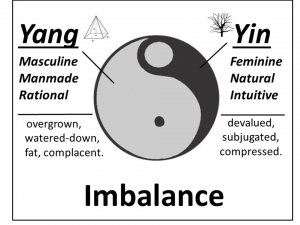Pyramids and Mother Nature

Pyramids of rectangular blocks are among the oldest and largest structures made by man. You will not see such shapes in nature. Built to facilitate reverence and respect for hierarchal social arrangement, they long ago proved to be effective at legitimizing the power of human authority. Without this, civilization would be either impossible, or radically different from what our planet has supported over the last few millennia. At the same time, to mistake what is manmade (our maps) for what is most essentially natural (the territory) can be fatal.
The Nile
For example, ancient Egyptian civilization quickly perished when the Nile, in accordance with natural macro-cycling, paused its annual flooding routine. The people depended on their new agricultural technologies, which in turn depended on the rich soil deposited annually near the banks of the Nile. The human intelligence at the time was not balanced by Mother Nature. It was unaware of, and did not account for, natural geologic phenomena.
Western Disease
The USDA food pyramid is another example of a bad map; manmade, lacking the balance of nature’s wisdom. The intent of the intelligence behind it was ostensibly to prevent, but instead it has promoted, disease; while simultaneously increasing GDP for the United States – via the profit centers of the grain business, sugar business, health care industry, drug companies, etc., the list goes on. Although it may not cause the fall of modern civilization on its own, the USDA food pyramid is certainly contributing to an accelerating global health crisis. If we were to value the health of human beings equal to, or more than, that of the US economy, would either figure out how to balance it, or abolish it.
Potential Modern “Nile” Effects
Any civilization can be resilient only by balancing man’s rational intelligence with the intuitive wisdom of Mother Nature. How confident can modern man be that he is taking into account the natural forces which can pose a threat? This is a particularly vexing question when one considers that man now engages in activities which have unprecedented power and scope to impact nature, yielding complex and severe effects that are very hard to model or predict. We see proof of such effects in desertification and topsoil depletion. Furthermore, suggestions to merely reflect on these activities frequently incite canned accusations of “environmental wacko” or “interfering with progress” by minions of a corporabanktocracy that has neither the well being of the planet, nor that of its inhabitants, in its mission. As Benjamin R. Clarke says in his essay The Real Aliens,
“We must be wary of ways of thinking that do not emulate and valorize the actual patterns of life itself. We must reconnect our imaginations and the products of our imaginations to our living world. This is the path of connection and belonging to the community of life. This is the true path to a sustainable future for our species on planet Earth. Beware the pyramid. Beware the square. Beware the pattern of the alien.”
While Pride in the pyramid triumphs over the Humble respect that nature commands, we hasten our fall. Indeed, Pride before the fall. Humbly reconnecting with nature shall restore balance, health, and resilience.




